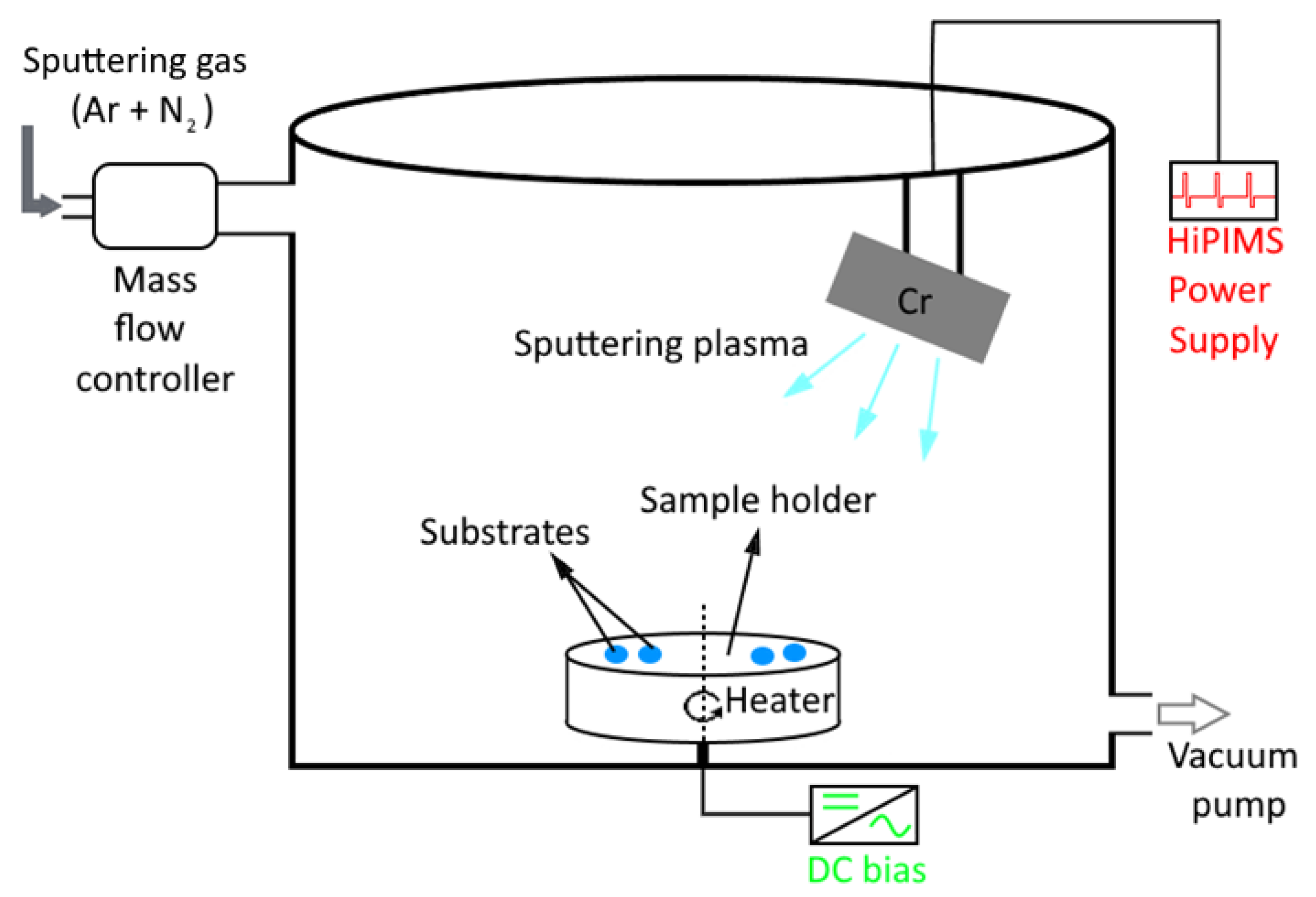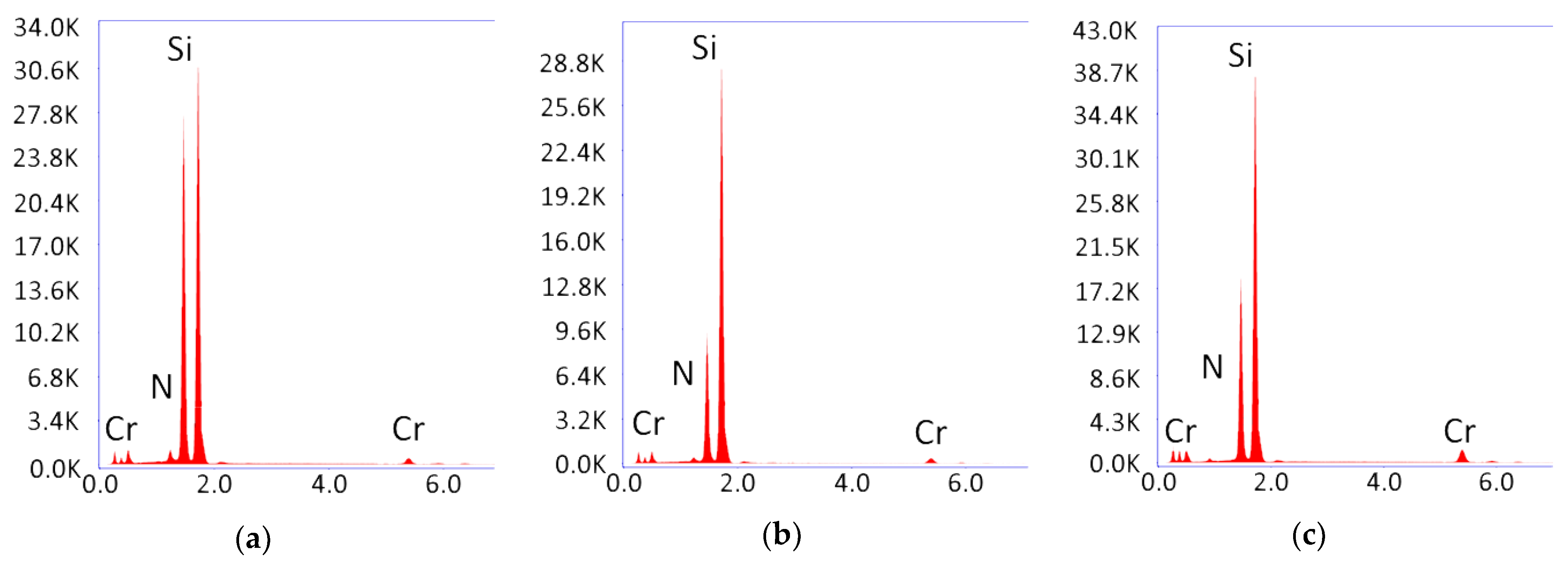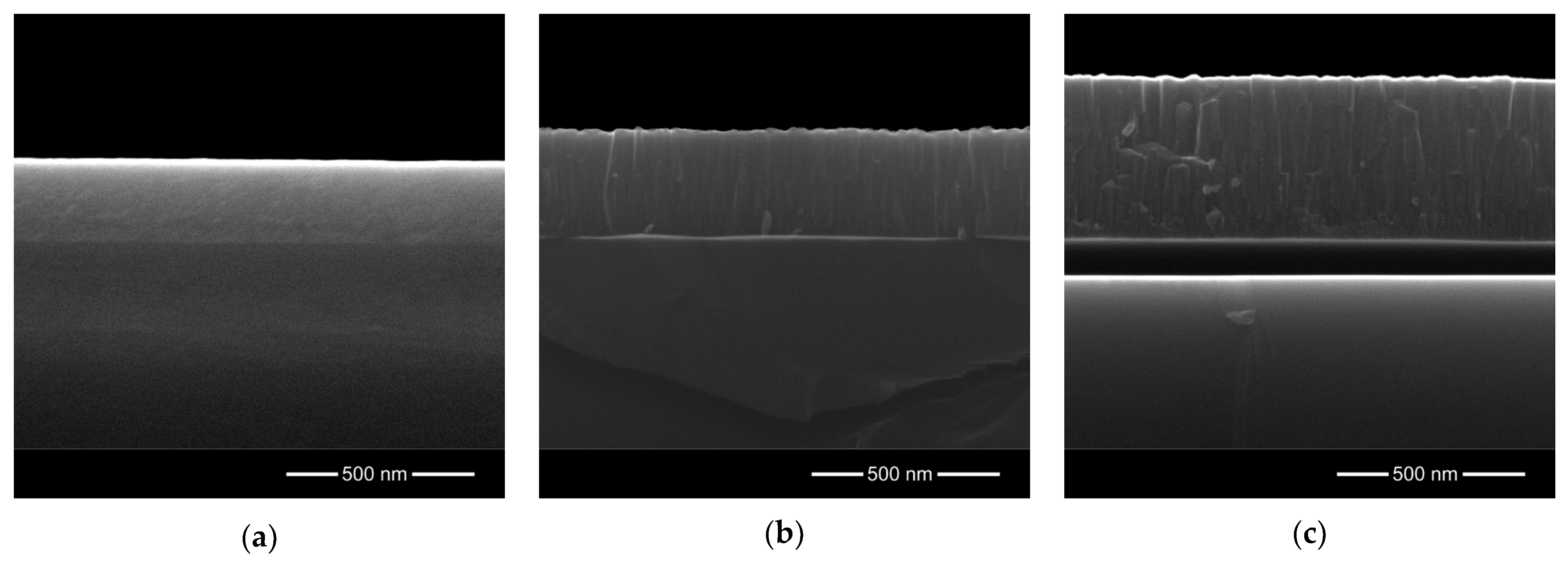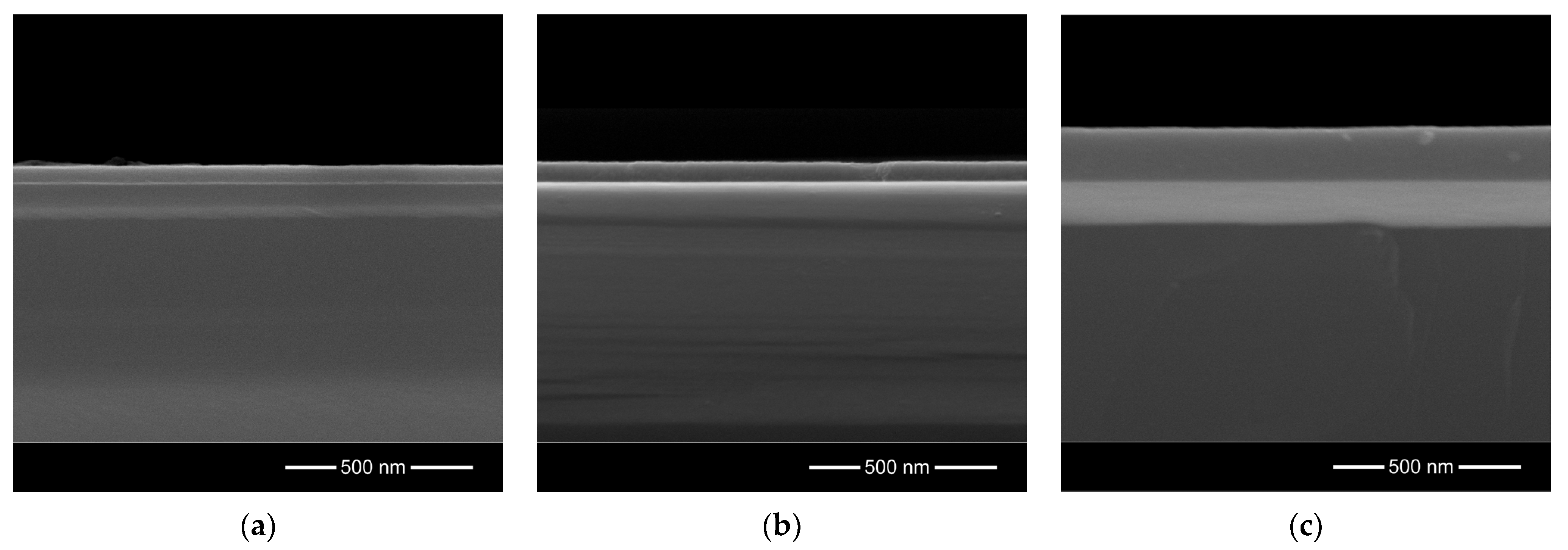Structural and Mechanical Properties of CrN Thin Films Deposited on Si Substrate by Using Magnetron Techniques
Abstract
1. Introduction
2. Materials and Methods
2.1. Sample Preparation
2.2. Characterisation Techniques
2.3. Image Analysis and Measurements
3. Results and Discussions
3.1. Chemical Composition
3.2. SEM Investigations
3.2.1. Surface Morphology
3.2.2. Surface Morphology Analysis
3.2.3. Film Thickness
3.3. AFM Investigations
3.3.1. Surface Topography
3.3.2. Mechanic (Elastic) Properties
3.3.3. Surface Topography Analysis
3.4. Water Contact Angle
4. Conclusions
Author Contributions
Funding
Institutional Review Board Statement
Informed Consent Statement
Data Availability Statement
Conflicts of Interest
References
- Robert Odette, G.; Cunningham, N.J.; Stan, T.; Ershadul Alam, M.; de Carlan, Y. Nano-Oxide Dispersion-Strengthened Steels. In Structural Alloys for Nuclear Energy Applications; Robert Odette, G., Zinkle, S.J., Eds.; Elsevier: Amsterdam, The Netherlands, 2019; pp. 529–583. [Google Scholar]
- Glasson, D.R.; Jayaweera, S.A.A. Formation and Reactivity of Nitrides I. Review and Introduction. J. Appl. Chem. 1968, 18, 65–77. [Google Scholar] [CrossRef]
- Eklund, P.; Kerdsongpanya, S.; Alling, B. Transition-Metal-Nitride-Based Thin Films as Novel Energy Harvesting Materials. J Mater. Chem. C Mater. 2016, 4, 3905–3914. [Google Scholar] [CrossRef]
- Barata, A.; Cunha, L.; Moura, C. Characterisation of Chromium Nitride Films Produced by PVD Techniques. Thin Solid Film. 2001, 398–399, 501–506. [Google Scholar] [CrossRef]
- Sanjinés, R.; Hones, P.; Lévy, F. Hexagonal Nitride Coatings: Electronic and Mechanical Properties of V2N, Cr2N and δ-MoN. Thin Solid Film. 1998, 332, 225–229. [Google Scholar] [CrossRef]
- Lin, J.; Moore, J.J.; Sproul, W.D.; Mishra, B.; Wu, Z.; Wang, J. The Structure and Properties of Chromium Nitride Coatings Deposited Using Dc, Pulsed Dc and Modulated Pulse Power Magnetron Sputtering. Surf. Coat Technol. 2010, 204, 2230–2239. [Google Scholar] [CrossRef]
- Ahn, S.H.; Choi, Y.S.; Kim, J.G.; Han, J.G. A Study on Corrosion Resistance Characteristics of PVD Cr-N Coated Steels by Electrochemical Method. Surf. Coat Technol. 2002, 150, 319–326. [Google Scholar] [CrossRef]
- Liu, C.; Bi, Q.; Matthews, A. EIS Comparison on Corrosion Performance of PVD TiN and CrN Coated Mild Steel in 0.5 N NaCl Aqueous Solution. Corros. Sci. 2001, 43, 1953–1961. [Google Scholar] [CrossRef]
- Zhou, L.; Körmann, F.; Holec, D.; Bartosik, M.; Grabowski, B.; Neugebauer, J.; Mayrhofer, P.H. Structural Stability and Thermodynamics of CrN Magnetic Phases from Ab Initio Calculations and Experiment. Phys. Rev. B Condens. Matter Mater. Phys. 2014, 90, 184102. [Google Scholar] [CrossRef]
- Abdallah, B.; Kakhia, M.; Alssadat, W.; Zetoun, W. Study of Power Effect on Structural, Mechanical Properties and Corrosion Behavior of CrN Thin Films Deposited by Magnetron Sputtering. Prot. Met. Phys. Chem. Surf. 2021, 57, 80–87. [Google Scholar] [CrossRef]
- Marulanda, D.M.; Olaya, J.J.; Patino, E.J. Evaluation of Electrical Properties of Cr/CrN Nano-Multilayers for Electronic Applications. J. Nanosci. Nanotechnol. 2011, 11, 5418–5422. [Google Scholar] [CrossRef]
- Cunha, L.; Andritschky, M.; Pischow, K.; Wang, Z. Microstructure of CrN Coatings Produced by PVD Techniques. Thin Solid Film. 1999, 355–356, 465–471. [Google Scholar] [CrossRef]
- Nouveau, C.; Djouadi, M.A.; Djouadi, M.A.; Banakh, O.; Sanjinés, R.; Lévy, F. Stress and Structure Profiles for Chromium Nitride Coatings Deposited by r.f. Magnetron Sputtering. Thin Solid Film. 2001, 398–399, 490–495. [Google Scholar] [CrossRef]
- Gilewicz, A.; Chmielewska, P.; Murzynski, D.; Dobruchowska, E.; Warcholinski, B. Corrosion Resistance of CrN and CrCN/CrN Coatings Deposited Using Cathodic Arc Evaporation in Ringer’s and Hank’s Solutions. Surf. Coat Technol. 2016, 299, 7–14. [Google Scholar] [CrossRef]
- Montemor, M.F. Functional and Smart Coatings for Corrosion Protection: A Review of Recent Advances. Surf Coat Technol 2014, 258, 17–37. [Google Scholar] [CrossRef]
- Aperador, W.; Duque, J.; Delgado, E. Electrochemical and Tribological and Mechanical Performances Coatings Multilayer Type NbC/CrN. Int. J. Electrochem. Sci. 2016, 11, 6347–6355. [Google Scholar] [CrossRef]
- Hultman, L. Thermal Stability of Nitride Thin Films. Vacuum 2000, 57, 1–30. [Google Scholar] [CrossRef]
- Muhammed Sabeer, N.A.; Pradyumnan, P.P. Augmentation of Thermoelectric Power Factor of P-Type Chromium Nitride Thin Films for Device Applications. Mater. Sci. Eng. B 2021, 273, 115428. [Google Scholar] [CrossRef]
- Wei, B.; Liang, H.; Zhang, D.; Wu, Z.; Qi, Z.; Wang, Z. CrN Thin Films Prepared by Reactive DC Magnetron Sputtering for Symmetric Supercapacitors. J. Mater. Chem. A Mater. 2017, 5, 2844–2851. [Google Scholar] [CrossRef]
- Zhu, M.; Huang, Y.; Huang, Y.; Li, H.; Wang, Z.; Pei, Z.; Xue, Q.; Geng, H.; Zhi, C. A Highly Durable, Transferable, and Substrate-Versatile High-Performance All-Polymer Micro-Supercapacitor with Plug-and-Play Function. Adv. Mater. 2017, 29, 1605137. [Google Scholar] [CrossRef]
- Liu, C.F.; Liu, Y.C.; Yi, T.Y.; Hu, C.C. Carbon Materials for High-Voltage Supercapacitors. Carbon N. Y. 2019, 145, 529–548. [Google Scholar] [CrossRef]
- Arif, M.; Sanger, A.; Singh, A. Sputter Deposited Chromium Nitride Thin Electrodes for Supercapacitor Applications. Mater. Lett. 2018, 220, 213–217. [Google Scholar] [CrossRef]
- Büldt, L.A.; Wenger, O.S. Chromium Complexes for Luminescence, Solar Cells, Photoredox Catalysis, Upconversion, and Phototriggered NO Release. Chem. Sci. 2017, 8, 7359–7367. [Google Scholar] [CrossRef] [PubMed]















| Designation | Power Supply Type | Deposition Time (min) |
|---|---|---|
| CrNDC5 | DC | 5 |
| CrNDC10 | DC | 10 |
| CrNDC15 | DC | 15 |
| CrNHi5 | HiPIMS | 5 |
| CrNHi10 | HiPIMS | 10 |
| CrNHi15 | HiPIMS | 15 |
| Sample | FD |
|---|---|
| CrNDC5 | 2.832 |
| CrNDC10 | 2.756 |
| CrNDC15 | 2.727 |
| CrNHi5 | 2.696 |
| CrNHi10 | 2.750 |
| CrNHi15 | 2.779 |
| Sample | Energy 1 Pixel | Energy 10 Pixels | Energy 100 Pixels | Correlation 1 Pixel | Correlation 10 Pixels | Correlation 100 Pixels |
|---|---|---|---|---|---|---|
| CrNDC5 | 0.074 | 0.074 | 0.074 | 0.033 | 0.007 | 0.001 |
| CrNDC10 | 0.164 | 0.163 | 0.163 | 0.043 | 0.026 | 0.004 |
| CrNDC15 | 0.180 | 0.180 | 0.180 | 0.085 | 0.050 | 0.006 |
| CrNHi5 | 0.235 | 0.235 | 0.235 | 0.064 | 0.018 | 0.010 |
| CrNHi10 | 0.156 | 0.156 | 0.156 | 0.072 | 0.004 | 0.004 |
| CrNHi15 | 0.125 | 0.125 | 0.125 | 0.067 | 0.009 | 0.003 |
| Sample Name | Film Thickness [nm] |
|---|---|
| CrNDC5 | 213 ± 4 |
| CrNDC10 | 282 ± 4 |
| CrNDC15 | 432 ± 5 |
| CrNHi5 | 44 ± 1 |
| CrNHi10 | 51 ± 2 |
| CrNHi15 | 144 ± 2 |
| Sample | Young’s Modulus [GPa] from Force–Distance Curves | Stiffness [N/m] from Nanoindentation |
|---|---|---|
| CrNDC5 | 370 ± 50 | 113 ± 2 |
| CrNDC10 | 280 ± 50 | 110 ± 2 |
| CrNDC15 | 240 ± 30 | 119 ± 1 |
| CrNHi5 | 250 ± 60 | 125 ± 2 |
| CrNHi10 | 160 ± 40 | 125 ± 1 |
| CrNHi15 | 140 ± 20 | 132 ± 2 |
| Sample Name | Sq [nm] | FD | S | L [nm] |
|---|---|---|---|---|
| CrNDC5 | 0.733 | 2.309 | −19.03 | 341.9 |
| CrNDC10 | 1.705 | 2.393 | −19.33 | 334.1 |
| CrNDC15 | 2.403 | 2.533 | −18.15 | 318.8 |
| CrNHi5 | 2.732 | 2.294 | −19.09 | 321.2 |
| CrNHi10 | 3.714 | 2.331 | −19.79 | 291.9 |
| CrNHi15 | 3.399 | 2.443 | −19.74 | 191.9 |
| Sample Name | Energy 1 Pixel | Energy 10 Pixels | Energy 100 Pixels | Correlation 1 Pixel | Correlation 10 Pixels | Correlation 100 Pixels |
|---|---|---|---|---|---|---|
| CrNDC5 | 0.539 | 0.487 | 0.459 | 0.544 | 0.384 | 0.164 |
| CrNDC10 | 0.440 | 0.371 | 0.354 | 0. 579 | 0.418 | 0.036 |
| CrNDC15 | 0.382 | 0.356 | 0.357 | 0. 772 | 0.201 | 0.031 |
| CrNHi5 | 0.578 | 0.496 | 0.455 | 0.691 | 0.460 | 0.042 |
| CrNHi10 | 0.555 | 0.483 | 0.442 | 0.673 | 0.497 | 0.171 |
| CrNHi15 | 0.317 | 0.276 | 0.253 | 0.726 | 0.605 | 0.235 |
Disclaimer/Publisher’s Note: The statements, opinions and data contained in all publications are solely those of the individual author(s) and contributor(s) and not of MDPI and/or the editor(s). MDPI and/or the editor(s) disclaim responsibility for any injury to people or property resulting from any ideas, methods, instructions or products referred to in the content. |
© 2023 by the authors. Licensee MDPI, Basel, Switzerland. This article is an open access article distributed under the terms and conditions of the Creative Commons Attribution (CC BY) license (https://creativecommons.org/licenses/by/4.0/).
Share and Cite
Tranca, D.E.; Sobetkii, A.; Hristu, R.; Anton, S.R.; Vasile, E.; Stanciu, S.G.; Banica, C.K.; Fiorentis, E.; Constantinescu, D.; Stanciu, G.A. Structural and Mechanical Properties of CrN Thin Films Deposited on Si Substrate by Using Magnetron Techniques. Coatings 2023, 13, 219. https://doi.org/10.3390/coatings13020219
Tranca DE, Sobetkii A, Hristu R, Anton SR, Vasile E, Stanciu SG, Banica CK, Fiorentis E, Constantinescu D, Stanciu GA. Structural and Mechanical Properties of CrN Thin Films Deposited on Si Substrate by Using Magnetron Techniques. Coatings. 2023; 13(2):219. https://doi.org/10.3390/coatings13020219
Chicago/Turabian StyleTranca, Denis E., Arcadie Sobetkii, Radu Hristu, Stefan R. Anton, Eugeniu Vasile, Stefan G. Stanciu, Cosmin K. Banica, Efstathios Fiorentis, David Constantinescu, and George A. Stanciu. 2023. "Structural and Mechanical Properties of CrN Thin Films Deposited on Si Substrate by Using Magnetron Techniques" Coatings 13, no. 2: 219. https://doi.org/10.3390/coatings13020219
APA StyleTranca, D. E., Sobetkii, A., Hristu, R., Anton, S. R., Vasile, E., Stanciu, S. G., Banica, C. K., Fiorentis, E., Constantinescu, D., & Stanciu, G. A. (2023). Structural and Mechanical Properties of CrN Thin Films Deposited on Si Substrate by Using Magnetron Techniques. Coatings, 13(2), 219. https://doi.org/10.3390/coatings13020219








